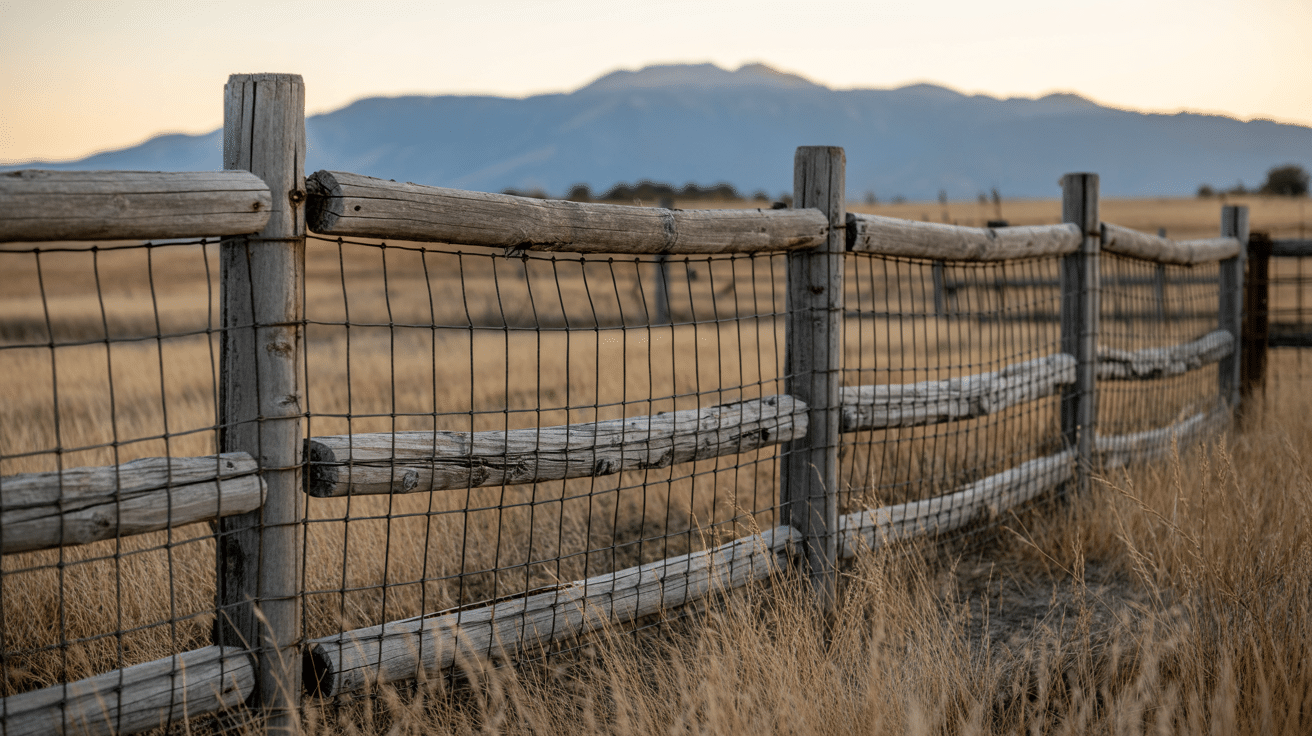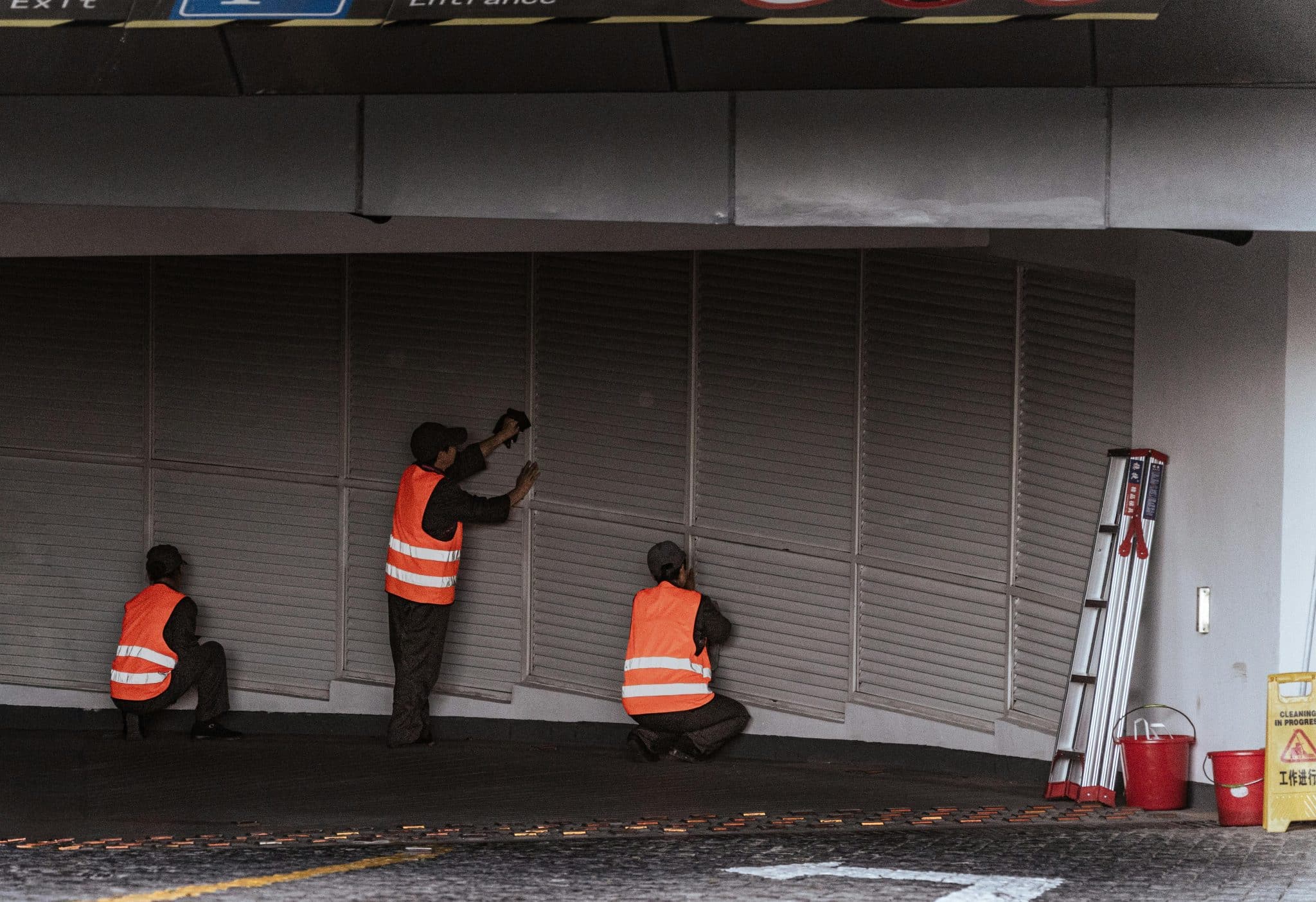Do you want a fence that offers both strength and style? Wood and wire fences might be just what you need.
These fences combine the warm, natural look of wood with the practical function of wire. Many homeowners pick this option because it balances good looks with useful features.
A good fence does more than mark your property line. It keeps kids and pets safe, adds charm to your yard, and can even boost your home’s value. Wood and wire fences check all these boxes while staying budget-friendly.
The beauty of these fences lies in their mix of materials. The wooden parts add a touch of nature to your property, while the wire mesh creates a solid barrier. This combo works well in many settings, from city homes to country farms.
What is a Wood and Wire Fence?
A wood and wire fence pairs wooden posts and rails with wire mesh. The wood parts give the fence structure and visual appeal. The wire fills the gaps to keep small animals in (or out) and adds security.
The basic parts include:
- Wooden posts sunk into the ground
- Horizontal wooden rails that connect the posts
- Wire mesh is attached to the rails and posts
- Hardware like nails, screws, and wire fasteners
You can choose from many wood types, such as cedar, pine, or oak. For the wire, options include welded wire mesh, chicken wire, or field fencing. Each combination creates a different look and serves other needs.
The most common setup uses wooden posts set 6-8 feet apart, with 2-4 horizontal rails running between them. Wire mesh attaches to these rails to create a solid barrier. The height varies based on your needs, but most range from 3 to 6 feet tall.
Benefits of a Wood and Wire Fence
With basic care, these fences last for years. Quality wood posts can stand firm for decades if properly treated, and the wire can withstand weather and wear.
You can adjust the design to fit your needs. Want more privacy? Add more wooden elements. Need to keep small pets safe? Choose smaller mesh holes in the wire.
Compared to all-wood, all-vinyl, or all-metal options, wood and wire fences cost less. You get the best of both worlds without the high price tag.
These fences also offer good security. The wire mesh makes it hard to get through, while the wood structure keeps the whole fence stable and strong.
The wood and wire combo fits in almost any setting. It looks at home in rural areas but also works well in the suburbs. The fence can blend with nature or stand out as a design feature, based on the wood and finish you choose.
Types of Wood and Wire Fences
1. Split Rail Wood and Wire Fence
This fence uses round or split wooden rails with wire mesh attached. It’s perfect for rural areas or larger properties. The rustic style is simple but functional, keeping larger animals contained while maintaining an open feel.
2. Picket Wood and Wire Fence
This style, a low picket fence paired with wire mesh behind it, works great for gardens or front yards. It adds charm and elegance while keeping small animals like rabbits and deer out of your plants.
3. Ranch-Style Wood and Wire Fence
This fence features horizontal wooden rails with wire mesh stretched between posts. Ideal for larger properties, farms, or ranches, it provides a classic and clean look while offering strong security for livestock containment.
4. Lattice Wood and Wire Fence
A lattice panel fence with wire mesh added for extra support. This style is perfect for gardens or patios, offering both decoration and functionality by keeping small animals out while still allowing some privacy.
5. Custom-Mix Wood and Wire Fence
This style combines different wood and wire elements to create a unique fence design. It allows for flexibility, whether you want a taller fence, more privacy, or a specific look, making it great for those looking to customize their fence to their needs.
Best Uses for Wood and Wire Fencing
For homes, these fences work well to define property lines without blocking views. They keep children and pets safely in the yard while still maintaining a nice appearance.
On farms and ranches, wood and wire fences contain livestock while enduring tough outdoor conditions. The wood posts provide strength, and the wire keeps animals where they belong.
Garden lovers use wood and wire fences to keep rabbits and deer away from plants. The wire stops critters, while the wood parts can serve as supports for climbing plants.
For basic security, these fences create a clear boundary that’s hard to cross without being seen. The open design means there’s nowhere to hide, which can deter trespassers.
Many people also use these fences to frame outdoor spaces like patios or play areas. They create a sense of room without making the space feel closed off.
Step-by-Step Installation Guide for wood and wire fence
Materials You’ll Need
- Wooden posts (pressure-treated or naturally rot-resistant)
- Rails (same material as posts)
- Wire mesh in your chosen style
- Post-hole digger or auger
- Level
- Hammer or drill
- Fencing staples or U-nails
- Wire cutters
- Concrete mix (optional but recommended)
- Measuring tape
- String and stakes for marking
- Saw for cutting wood
- Work gloves and safety glasses.
Having a helper makes the job much easier, especially when handling long sections of wire mesh.
Step 1: Planning and Preparation
Check local building codes and get permits if needed. Call utility companies to mark underground lines before digging. Measure and mark your fence line using stakes and string. Mark post locations along the string line, typically spacing them 6-8 feet apart.
Step 2: Setting the Posts
Dig holes for your posts. Make them 3 times the width of your post and 1/3 of the post height deep. Add 3-4 inches of gravel at the bottom of each hole for drainage.
Set your first corner post in its hole, using a level to ensure it’s straight. If using concrete, mix it according to the package directions. Hold the post in place while adding concrete or soil around it.
Check with the level again to make sure the post is perfectly straight. Set all corner posts first, then move to line posts. Let the posts sit for at least 24 hours before moving to the next step.
Step 3: Adding the Rails
Measure and mark the height for your rails on the posts. Cut rails to length if needed. Attach the bottom rail first, securing it to the posts with nails or screws.
Make sure the rail is level before securing it fully. Repeat with the top rail and any middle rails. For best results, use galvanized or weather-resistant fasteners.
Step 4: Attaching the Wire Mesh
Unroll the wire mesh along the fence line. Start at one end and secure the mesh to the first post with staples or U-nails. Pull the mesh tight as you move to the next post.
Attach the top of the mesh to the top rail first, then the bottom. For best results, work in sections of 1-2 post spans. Use fencing staples every 6-8 inches along the rails and posts.
When joining two pieces of mesh, overlap them by at least 4 inches. Secure both pieces to the same post for added strength.
Step 5: Finishing Touches
Trim any excess wire using wire cutters. If desired, apply a cap to the top of each post to prevent water damage. Check the entire fence for sharp wire ends and bend them back.
If the wooden parts aren’t pre-treated, apply wood sealer or stain to them. Clean up the area around the fence, removing any leftover materials and filling in any holes from the work.
Tips and Tricks for Success
- Set corner posts first, then run string lines between them to ensure all other posts align perfectly.
- Pre-drill holes for screws in the wood to prevent splitting.
- When stretching wire mesh, start in the middle of a section and work outward.
- On sloped ground, step the fence rather than following the slope for a cleaner look.
- To prevent rot, leave a small gap (1-2 inches) between the bottom of the fence and the ground.
- Wear heavy work gloves when handling wire mesh to avoid cuts.
- Check posts with a level frequently during installation.
Maintenance Tips for Wood and Wire Fences
-
Check Twice a Year: Inspect the fence for loose wire, wobbly posts, or damaged wood. Address small issues immediately to prevent bigger problems.
-
Maintain the Wood: Clean the wooden parts yearly and apply a wood sealer or stain every 2-3 years to prevent rot and keep the fence looking fresh.
-
Tighten Wire: Tighten any loose sections of wire and replace rusted or broken mesh. Use a wire stretcher tool to keep the mesh tight between posts.
-
Clean Wooden Parts: Use a soft brush to remove dirt and moss. For stubborn stains, use a mild soap and water mix (avoid pressure washing, as it can damage wood fibers).
-
Check After Winter: In areas with snow, inspect the fence in spring after the ground thaws. Freeze-thaw cycles can cause posts to shift or lean.
Cost Considerations
An average wood and wire fence costs between $10 and $20 per linear foot for materials and labor. A DIY job can cut that nearly in half if you have the right tools and skills.
Factors that affect price include:
- Type and quality of wood
- Type and gauge of wire
- Height and length of the fence
- Ground conditions (rocky soil means harder digging)
- Local labor rates
Despite the upfront cost, these fences save money long-term. They need less maintenance than all-wood fences and last longer than many cheap options.
For a typical suburban lot (about 150-200 linear feet of fencing), expect to pay $1,500-$4,000 for materials. Professional installation adds another $1,500-$3,000, depending on your location.
Common Mistakes to Avoid When Installing a Wood and Wire Fence
-
Not Setting Posts Deep Enough: Failing to set posts deep enough can cause the fence to lean or fall. Ensure posts are at least 2 feet deep, and deeper for taller fences or windy areas.
-
Using Incorrect Wood: Wood that isn’t rated for ground contact will quickly rot. Always choose pressure-treated lumber or naturally resistant woods like cedar.
-
Not Accounting for Local Weather: Ignoring local weather conditions can lead to issues. In cold climates, posts must go below the frost line. In wet areas, extra drainage around posts is essential to prevent rot.
-
Stretching Wire Too Tight: Stretching wire mesh too tight can cause the wood structure to warp over time. The wire should be taut but not overly tight to avoid pulling on the posts or rails.
-
Failing to Check Property Lines: Not confirming property boundaries can lead to conflicts with neighbors. Always check and verify your property lines before installing a fence.
-
Using the Wrong Fasteners: Using non-galvanized nails or staples will cause rust stains and early fence failure. Always use fasteners that are designed for outdoor use and are resistant to rust.
Conclusion
Wood and wire fences offer a perfect blend of form and function. They look better than plain wire fences, cost less than all-wood options, and serve many purposes, from keeping pets safe to marking property lines.
When planning your fence, consider what you need it to do and how you want it to look. With the right materials and proper installation, your wood and wire fence will be strong and look good for many years.
These fences bring together the best aspects of different fencing types. The warmth of wood adds curb appeal, while the strength of wire mesh provides security. It’s no wonder they remain a top choice for homeowners across the country.
Have you installed a fence before? What type worked best for your needs? Share your thoughts in the comments below!


















